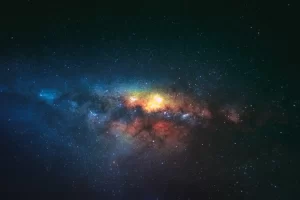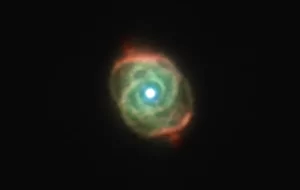
The Cat’s Eye Nebula, also known as NGC 6543, is one of the most fascinating and well-studied planetary nebulae in the sky. Located in the constellation Draco, the Cat’s Eye Nebula is a stunning example of a dying star shedding its outer layers in a dramatic display of color and structure. Its name comes from its striking resemblance to the shape of a cat’s eye, a feature that has captivated astronomers and stargazers alike. This nebula is not only visually impressive but also offers a wealth of information about the life cycle of stars and the processes that occur during their final stages.
What is a Planetary Nebula?
Despite the name, a planetary nebula has nothing to do with planets. The term was coined by astronomers in the 18th century, when early telescopes viewed these objects and thought they resembled the appearance of distant planets. In reality, a planetary nebula is a shell of gas and dust ejected by a star in the final stages of its evolution, typically from a star that is similar in size to our Sun.
When stars of this size reach the end of their lives, they exhaust the hydrogen fuel in their cores. As a result, the core contracts and heats up, while the outer layers expand and cool. Eventually, the outer layers are ejected into space, creating the glowing shell of gas that forms a nebula. The ultraviolet radiation from the hot core ionizes the ejected gas, causing it to glow in vibrant colors.
The Cat’s Eye Nebula: A Snapshot of a Dying Star
The Cat’s Eye Nebula, NGC 6543, is located about 3,000 light-years from Earth in the constellation Draco. It is one of the closest and most well-known examples of a planetary nebula, and it provides astronomers with an excellent opportunity to study the dynamics and structure of this cosmic phenomenon.
The nebula spans about 1.5 light-years across and is thought to be roughly 1,000 to 2,000 years old, though it’s possible that the ejection of its outer layers began even earlier. The central star, a white dwarf, is all that remains of the progenitor star that once shed its outer layers. This white dwarf, which is incredibly dense and hot, provides the ultraviolet radiation responsible for ionizing the gas surrounding it and causing it to glow.
Structure and Features of the Cat’s Eye Nebula
One of the most striking features of the Cat’s Eye Nebula is its complex, multi-ringed structure. The nebula consists of concentric rings of gas, often described as resembling the layers of an onion. These rings, which are made of ionized hydrogen and other elements, were created by the ejection of material from the star during its later stages of evolution. These rings are not perfectly symmetrical, and some appear to be twisted or asymmetrical, suggesting that the process of mass ejection was not uniform.
In addition to its rings, the Cat’s Eye Nebula contains a number of interesting structures, including:
- Jets and filaments: The nebula contains high-speed jets of gas and filaments that extend outward from the central white dwarf. These jets are likely the result of the star’s intense magnetic fields and interactions with the surrounding gas.
- Bipolar outflows: The nebula shows evidence of bipolar outflows, which are streams of gas that are ejected along the poles of the star. These outflows are seen in many planetary nebulae and suggest that the star’s magnetic field may play a role in shaping the nebula.
- Colorful emissions: The Cat’s Eye Nebula is rich in emission lines from ionized gases, most notably oxygen (OIII), which produces a distinctive blue-green color, and hydrogen (H-alpha), which emits red light. The variety of colors observed in the nebula results from the different elements being ionized at varying distances from the central star and the varying energy levels of the light emitted.
The Central Star: A White Dwarf
At the heart of the Cat’s Eye Nebula is a white dwarf, the remnant of the star that created the nebula. White dwarfs are the dense, cooling remnants of stars that were not massive enough to end their lives in a supernova explosion. These stars exhaust their fuel and expel their outer layers, leaving behind a hot, dense core that gradually cools and fades over billions of years.
The white dwarf at the center of the Cat’s Eye Nebula is extremely hot, with temperatures exceeding 100,000 K (Kelvin). It is believed to be responsible for emitting the ultraviolet radiation that ionizes the gas in the nebula, causing it to glow. As the white dwarf cools over time, it will eventually become a black dwarf, a cold, dark remnant that no longer emits significant light or heat.
What Can We Learn from the Cat’s Eye Nebula?
The Cat’s Eye Nebula is an invaluable object for astronomers studying the late stages of stellar evolution. The nebula provides insight into the following aspects of stellar life cycles:
1. Stellar Evolution and the Fate of Sun-like Stars
The Cat’s Eye Nebula offers a glimpse into what will happen to our Sun in approximately 5 billion years when it reaches the end of its life. Our Sun will eventually become a red giant, shedding its outer layers and leaving behind a white dwarf at its core. While our Sun’s mass is not large enough to end its life in a supernova, it will produce a planetary nebula similar to the Cat’s Eye Nebula. Studying objects like NGC 6543 helps scientists understand the processes involved in the final stages of a star’s life and the formation of white dwarfs.
2. Gas Ejection and Nebula Formation
The Cat’s Eye Nebula is a perfect example of how gas and dust are expelled from a dying star, forming intricate and beautiful structures. The nebula’s complex ring system provides astronomers with clues about how stars lose mass and how the surrounding gas interacts with the star’s magnetic fields. By studying these structures, scientists can refine their models of how planetary nebulae form and evolve over time.
3. Chemical Composition of Nebulae
Planetary nebulae, including the Cat’s Eye Nebula, are rich in chemical elements such as hydrogen, oxygen, nitrogen, and carbon. The process of a star’s death and the subsequent expulsion of gas enrich the surrounding interstellar medium with these elements. Over time, the material ejected by stars can become part of new generations of stars and planets, playing a key role in the ongoing process of cosmic recycling.
4. The Role of Magnetic Fields in Shaping Nebulae
The Cat’s Eye Nebula shows evidence of the important role that magnetic fields play in shaping the structure of planetary nebulae. The asymmetry of the nebula’s rings and the presence of bipolar outflows suggest that the central star’s magnetic field may be influencing the way gas is ejected from the star and arranged around it. This is an area of active research, as scientists continue to investigate how magnetic fields interact with gas and dust in the late stages of stellar evolution.
Observing the Cat’s Eye Nebula
The Cat’s Eye Nebula is visible with a small telescope, though its detailed features are best observed with a larger telescope or through high-resolution images from space telescopes such as the Hubble Space Telescope. The nebula’s intricate structure and vibrant colors make it a popular target for both professional astronomers and amateur stargazers. Hubble’s images of the Cat’s Eye Nebula have provided some of the most detailed views of any planetary nebula, allowing scientists to study the fine structure of the nebula and its central star in unprecedented detail.
Conclusion
The Cat’s Eye Nebula is one of the most beautiful and scientifically valuable objects in our night sky. It offers a stunning display of color and structure, showcasing the intricate process by which a star sheds its outer layers in the final stages of its life. By studying the Cat’s Eye Nebula, astronomers can gain a deeper understanding of stellar evolution, the formation of planetary nebulae, and the fate of stars like our Sun. Its unique features and rich scientific potential make it a key object in the study of the cosmos, and it will continue to inspire astronomers and stargazers for generations to come.




